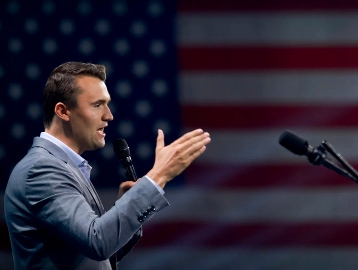It has been quite a few years since I watched
The Sound of Music
, a moving depiction of the nun Maria’s journey as governess to a military family against the backdrop of the Anschluss. (Spoilers up ahead.) That backdrop serves as a long-term threat to the family’s safety, lurking as the interpersonal conflicts of the film wriggle and resolve; across its narrative arc, the unease of the encroaching Third Reich and Captain von Trapp’s exchanges with the increasingly ideologically-minded Rolf foreshadow the shadow of fascism sweeping into Salzburg. Yet when Austria is finally annexed, the family is nevertheless caught unawares, ill-prepared to act against a threat they had seen coming from miles away.
Unlike Austria in 1938, the United States has not yet descended into the horrors of openly fascistic statecraft. Joe Biden will remain president until January, and Donald Trump’s first term did not result in a national moral capitulation on par with that of the Axis Powers. That being said, considering the bizarre company that the president-elect keeps, one can make no guarantees as to the direction of the U.S. government under Republican stewardship over the next four years.
Given the bloodbath of Election Day, it is easy to understand why pessimism is currently running amok within the Democratic Party. After all, in an age where sinister and erratic forces have hijacked one of the U.S.’s two primary political parties, the greatest guarantor of stability is the ascendancy of its counterpart. However, while Kamala Harris undoubtedly suffered a crushing defeat this Election Day, Democrats still have reason to be optimistic. As Maria departs the nunnery to embark on her new domestic role, she opines that “when the Lord closes a door, somewhere He opens a window;” irrespective of one’s religiosity, it remains the case that the Democratic Party now has a rare chance to reinvent itself, realigning its priorities and fixing its messaging in order to recapture the faith and trust of the American electorate.
In order to plan for the future, however, one must first examine just what the hell happened on November 5. Over the course of this article and sequels in the coming weeks, I shall conduct an autopsy of sorts to show why the Democrats put up such a poor showing on the national level, as well as recommend courses of action they ought to take to reverse their dramatic losses. First up: the party’s increasingly stark inability to retain nonwhite voters.
One of the most striking shifts this Election Day occurred within demographics that Democrats by-and-large considered certain to vote blue en masse: racial minorities. According to the Associated Press, every single racial minority in the U.S. moved Republican in 2024, in spite of the disparaging rhetoric that Trump used toward them. Black and Hispanic voters each swung by 15%, a political sea change in areas where Democratic advisors once assumed a steady base of support. NBC News exit polls reported that Native Americans voted for Trump at nearly twice the rate that they did for Harris; even though these numbers are likely inflated due to a lack of polling on tribal land, they still reflect a considerable abandonment of previous voting trends.
On some levels, this is a blessing in disguise. For too long, American liberals have taken racial minorities for granted in the electoral process, relying too heavily upon the bigotry of other candidates and too little upon meeting the concerns of minority voters. Democrats’ arrogant, triumphalist Obama-era proclamation that “demographics are destiny” is officially dead in the water — now they can actually give these key voters the time of day.
At the heart of much of the abandonment of Democrats by racial minority voters are the American electorate’s widespread concerns over immigration. While immigration numbers are down under Biden, data that would have delighted many an American voter had Democrats mentioned it more often, they still tied themselves in knots talking about how to handle the immigration process. They routinely failed to press Republicans for tanking the Border Act of 2024 on Trump’s instruction, and ceded ground on the subject by only sparingly discussing its contents on the campaign trail. More tellingly, instead of explaining her shift to a more aggressive stance on border security, Harris (along with down-ballot Democrats) merely adopted a stance closer to the median voter without addressing the shift at all. By not explaining why she changed her stance, Harris subsequently lacked a defense against potential doubts that her positions were genuine.
There is also a naïveté to how Democrats address immigration with Hispanic voters, insofar as they assume some sort of racial camaraderie between new Hispanic immigrants and families that have lived in the U.S. for multiple generations. In reality, no such bond exists outside the auspices of progressive advocacy groups which, despite their intentions, do not accurately represent the beliefs of the people they try to represent. As long as they continue to allow these organizations to exercise an outsized degree of influence on their policymaking, Democrats will continue to alienate Hispanic voters perceptive enough to identify that the party does not have a good handle on what they want. After all, the single largest share of the Hispanic vote that any contemporary Democratic presidential candidate has won belongs to one Bill Clinton, who famously advocated for restrictive border policies. Clinton nevertheless received exceptional support from Hispanic voters, not because these voters felt strongly about open borders, but because he advocated for down-to-earth policies that opened pathways to long-term financial improvement for the working poor, such as funding public education up the wazoo.
Advocacy groups also wield a disproportionate amount of influence over Democratic messaging, which feeds into another problem: the cultural policies of the Democratic Party are remarkably unpopular with the traditional conservative attitudes of many racial minority families, particularly among older voters. In spite of this latent unpopularity, prominent liberals have dedicated an quite a lot of time and energy to evangelizing these topics on the national stage. (While blue politicians have recognized as of late that these ideas are exceptionally poor selling points for the American public, liberal-minded media coverage often places these issues front-and-center, operating in lockstep with advocacy groups.) This is not to say that Democrats should uniformly abandon or switch their stances on these issues, nor lie about their stances when explicitly asked about them, but by placing social issues so visibly in the foreground of their campaign, they risk constantly reminding socially conservative minority voters of their least favorite aspects of the Democratic platform. Black voters in particular have been, according to this election’s exit polls, much more receptive to economic arguments in favor of winning their votes. Even if they do not flip, mere apathy could depress turnout in the very demographics that have helped Democrats secure narrow election victories in the past.
It therefore follows that Democrats’ reluctance to forcefully argue their border policies, their inaccurate assumptions about Hispanic voters in particular and an ill-advised deference to the culturally-minded whims of advocacy groups caused a significant number of racial minorities to jump ship this election.
In this project’s next serial, I shall discuss the Democratic Party’s inability to rein in unpopular narratives coming from within itself which taint the median voter’s opinion of the party as a whole.
























